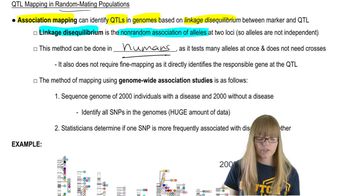Table of contents
- 1. Introduction to Genetics51m
- 2. Mendel's Laws of Inheritance3h 37m
- 3. Extensions to Mendelian Inheritance2h 41m
- 4. Genetic Mapping and Linkage2h 28m
- 5. Genetics of Bacteria and Viruses1h 21m
- 6. Chromosomal Variation1h 48m
- 7. DNA and Chromosome Structure56m
- 8. DNA Replication1h 10m
- 9. Mitosis and Meiosis1h 34m
- 10. Transcription1h 0m
- 11. Translation58m
- 12. Gene Regulation in Prokaryotes1h 19m
- 13. Gene Regulation in Eukaryotes44m
- 14. Genetic Control of Development44m
- 15. Genomes and Genomics1h 50m
- 16. Transposable Elements47m
- 17. Mutation, Repair, and Recombination1h 6m
- 18. Molecular Genetic Tools19m
- 19. Cancer Genetics29m
- 20. Quantitative Genetics1h 26m
- 21. Population Genetics50m
- 22. Evolutionary Genetics29m
20. Quantitative Genetics
QTL Mapping
Problem 29c
Textbook Question
In 1988, Horst Wilkens investigated blind cavefish, comparing them with members of a sibling species with normal vision that are found in a lake [Wilkens, H. (1988). Evol. Biol. 25:271–367]. We will call them cavefish and lakefish. Wilkens found that cavefish eyes are about seven times smaller than lakefish eyes. F₁ hybrids have eyes of intermediate size. These data, as well as the F₁×F₁ cross and those from backcrosses (F₁×cavefish and F₁×lakefish), are depicted below. Examine Wilkens's results and respond to the following questions:
Based on the results of the F₁ backcross with lakefish, is your explanation supported? Explain.
 Verified step by step guidance
Verified step by step guidance1
<span>1. Understand the genetic basis of the trait: The eye size difference between cavefish and lakefish is likely due to genetic factors. The F₁ hybrids having intermediate eye size suggests incomplete dominance or additive genetic effects.</span>
<span>2. Analyze the F₁ backcross with lakefish: In a backcross, the F₁ hybrid is crossed with one of the parental types, in this case, the lakefish. This helps to determine the genetic contribution of the lakefish alleles to the trait.</span>
<span>3. Predict the expected outcomes: If the trait is controlled by a single gene with incomplete dominance, the backcross should produce offspring with a range of eye sizes, some closer to the lakefish size and some intermediate.</span>
<span>4. Compare the observed results with expectations: Examine the data from the backcross to see if the distribution of eye sizes matches the predicted outcomes. This can help confirm if the genetic model (e.g., incomplete dominance) is supported.</span>
<span>5. Draw conclusions: If the observed results align with the expected outcomes based on the genetic model, then the explanation of genetic control of eye size is supported. If not, consider alternative genetic models or additional factors that might influence the trait.</span>
Recommended similar problem, with video answer:
 Verified Solution
Verified SolutionThis video solution was recommended by our tutors as helpful for the problem above
Video duration:
3mPlay a video:
Was this helpful?
Key Concepts
Here are the essential concepts you must grasp in order to answer the question correctly.
Hybrid Vigor and Intermediate Traits
Hybrid vigor, or heterosis, refers to the phenomenon where hybrid offspring exhibit traits that are intermediate between their parent species. In the case of the cavefish and lakefish, the F₁ hybrids have eyes of intermediate size, suggesting that the traits for eye size are influenced by multiple genes. This concept is crucial for understanding how traits can blend in hybrids and how these traits can be analyzed in genetic studies.
Recommended video:
Guided course

Traits and Variance
Backcrossing in Genetics
Backcrossing is a breeding method where hybrid offspring are crossed back with one of their parent species. This technique helps to analyze the inheritance of specific traits and can reveal the genetic contributions of each parent. In the context of the cavefish and lakefish study, the F₁ backcross with lakefish allows researchers to determine if the traits observed in hybrids are consistent with the genetic contributions from the lakefish parent.
Recommended video:
Guided course

Descriptive Genetics
Quantitative Trait Loci (QTL)
Quantitative Trait Loci (QTL) are regions of the genome that are associated with the variation in a quantitative trait, such as eye size. The study of QTL helps in identifying the specific genetic factors that contribute to phenotypic differences. Understanding QTL is essential for interpreting the results of Wilkens's experiments, as it provides insight into the genetic basis of the observed differences in eye size between cavefish and lakefish.
Recommended video:
Guided course

QTL Mapping
Related Videos
Related Practice




